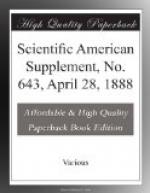Further, the allotropic modifications of elements and the isomerism of compounds increased the difficulties. Why should yellow phosphorus be an active poison and red phosphorus be inert? Why should piperine be the poison of all poisons to keep you awake, and morphine the poison of all poisons to send you asleep, although to the chemist these two bodies were of identical composition? The lecturer urged that the science of medicine (for the poisons of the toxicologist were the medicines of the physician) must be experimental. Guard jealously against all wanton cruelty to animals; but to deprive the higher creation of life and health lest one of the lower creatures should suffer was the very refinement of cruelty. “Are ye not of much more value then they?” spoke a still small voice amid the noisy babble of well intentioned enthusiasts.—London Times.
* * * * *
ARTIFICIAL MOTHER FOR INFANTS.
All the journals have recently narrated the curious story of the triplets that were born prematurely at the clinic of Assas Street. Placed at their birth in an apparatus constructed on the principle of an incubator, in order to finish their development therein, these frail beings are doing wonderfully well, thanks to the assiduous care bestowed upon them, and are even showing, it appears, a true emulation to become persons of importance.
Every one now knows the incubator or “artificial hen”—that box with a glass top in which, under the influence of a mild heat, hens’ eggs, laid upon wire cloth, hatch of themselves in a few days, and allow pretty little chicks to make their way out of the cracked shell.
This ingenious apparatus, which has been adopted by most breeders, gives so good results that it has already supplanted the mother hens in all large poultry yards, and at present, thanks to it, large numbers of eggs that formerly ended in omelets are now changing into chickens.
Although not belonging to the same race, a number of children at their birth are none the less delicate than these little chicks.




